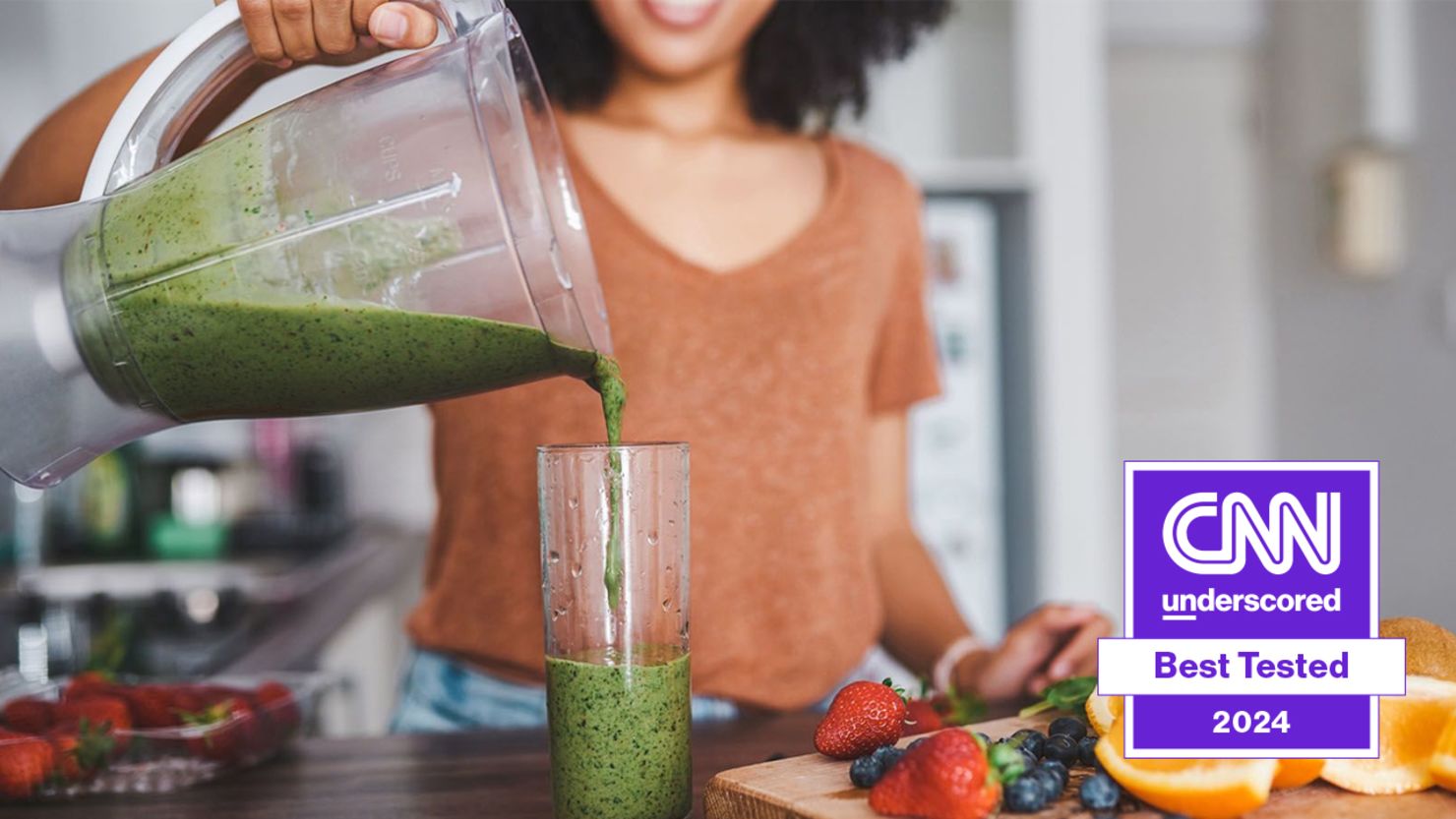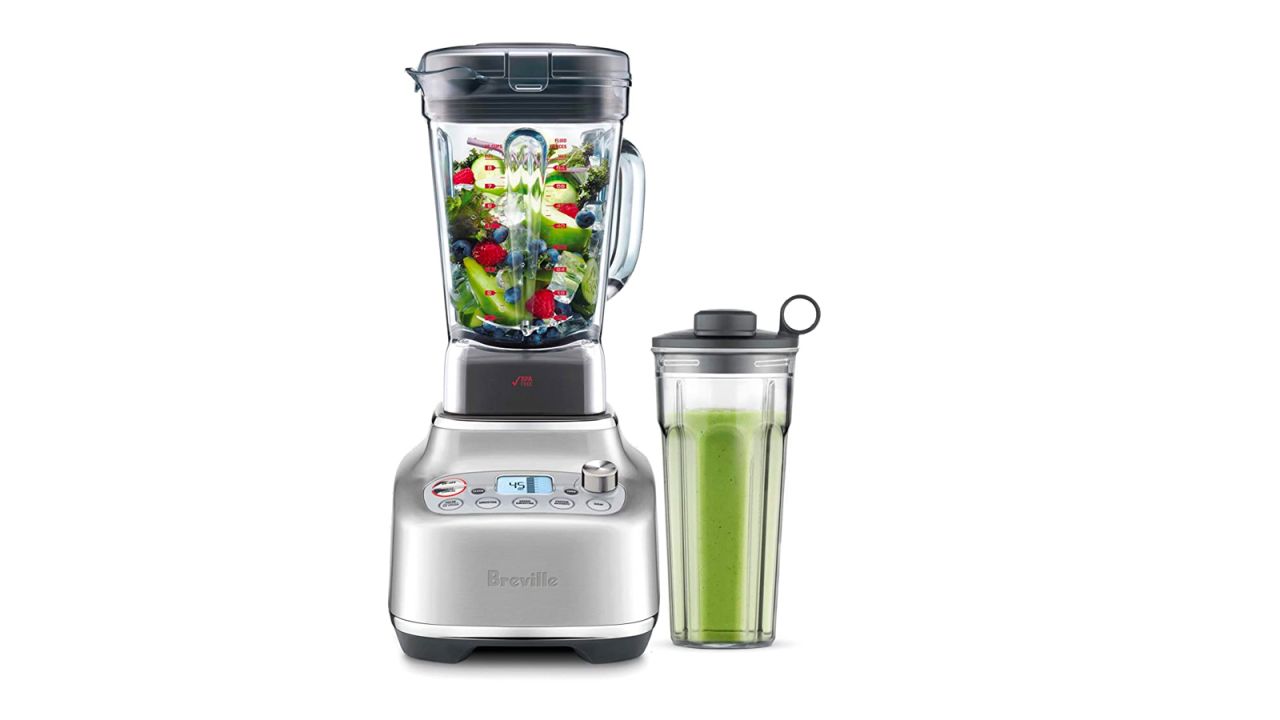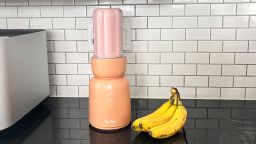Editor’s Note: The Vitamix Venturist, our previous luxury pick, has gone down in price and is now our runner-up for best blender. We’re currently testing to update this piece with a replacement.
The best blenders we tested:
Best blender: Breville Super Q
Runner-up for best blender: Vitamix Venturist V1200
Best budget blender: Ninja Professional Plus Blender with Auto-iQ
With so many options — and a huge range of price tags — picking the right kitchen appliances can be tricky, especially when it comes to blenders. To help settle the score, we put nine popular blenders to the test, whipping up smoothies, soups and nut butter and pulverizing ice to find the models that produced the creamiest, silkiest textures and had the best functionality, durability and more.
The bottom line: Higher cost also means increased performance and a longer-lasting machine, so if you’re a frequent blender, we think they’re worth the investment in the long run (and just think how much you’ll save by skipping your daily $8 smoothie and making your own version at home). But if you rarely have the need to blend — and prefer Skippy to your own custom almond butter — a budget model should suit your needs just fine.
After lots of blending, tamping, cleaning and avoiding noise complaints from the neighbors, we narrowed it down to three winners:
The Breville Super Q features a slew of preset buttons, comes in multiple colors, includes key accessories and is quieter than other models. It does carry a steep price tag, but for those who can't imagine a smoothie-less morning, what breaks down to about $1.50 a day over a year seems like a bargain.
With its whopping 10-year warranty and plethora of functional, durable and just plain cool features, the Vitamix Venturist V1200 quickly became one of our favorite blenders.
Besides doing an admirable job at blending up creamy soups and smoothies, the Ninja Professional Plus Blender comes with a number of presets, as well as low, medium and high manual settings. It doesn't have the heft or quality materials of the high-performance blenders we tested, but for casual users, it won't disappoint.
Best blender: Breville Super Q
From $535 at Amazon
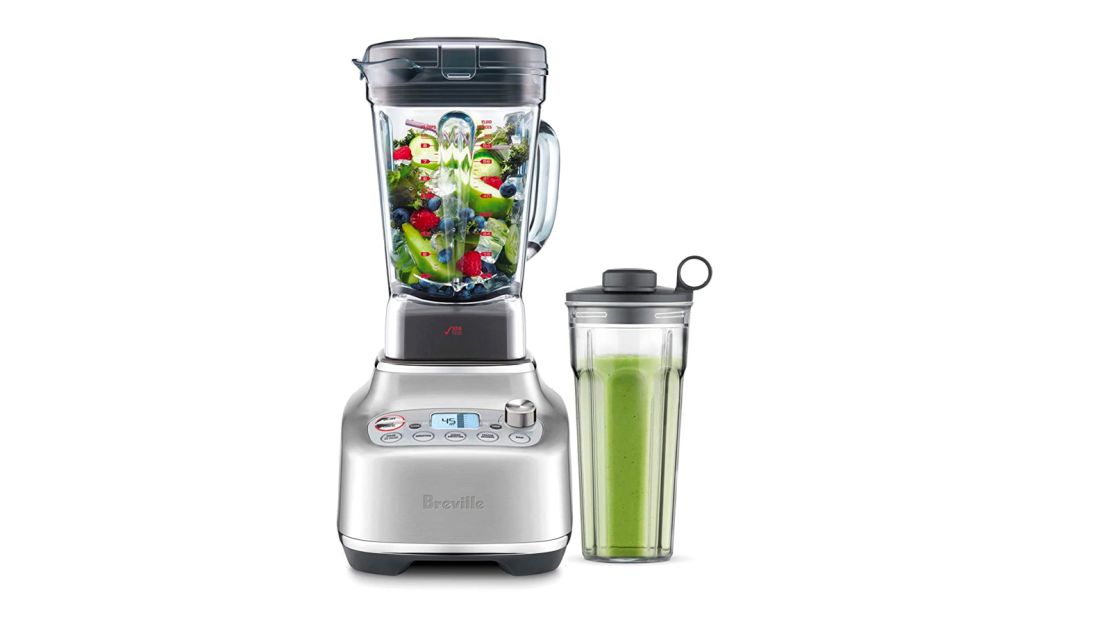
The world’s fastest roller coaster reaches 150 miles an hour. A cheetah can run at about 75 miles an hour. Usain Bolt, the world’s fastest man, clocks in at 28 miles per hour. So when we read that the Breville Super Q boasts surgical stainless steel blades that can get up to 186 miles an hour, we were impressed. But not terribly surprised. No wonder our spinach disappeared into our smoothie in seconds.
Those blades, along with a big-time 1,800-watt motor in a hefty blender with a sleek design, delivered high marks on all of our tests, turning out creamy smoothies, perfectly blended hot soups, and such delicately crushed ice that we decided to declare every evening from here on out boozy slushie night.
The commercial-grade Super Q (the Q is for quick and quiet) comes in six colors (brushed stainless steel, black, gray, white, champagne and navy), and includes a large 68-ounce BPA-free Tritan jug, as well as a 24-ounce blender cup. The lid includes a nifty inner measuring cup that can hold up to 2 ounces (fewer dirty dishes are always a plus). When you’re done blending, a button on the lid releases the suction, making it easier to remove — the finger hold ring also helps. We share this because before we discovered this trick, we were worried we’d break the lid trying to pry it off the jar.
At 22 pounds, it’s heavy and durable. The model also gets points for its ease of use. Preset buttons include pulse/ice crush, smoothie and green smoothie (also making it the best blender for smoothies), frozen dessert, soup, clean and timer. There’s an on/off and pause/cancel button and a manual dial with 12 speed settings including pause, stir, mix, chop, blend, puree and mill and hot soup. An LCD screen gives you a digital display readout, and, in the box, you’ll find a tamper, scraper and hardcover cookbook.
We were especially impressed with the hot soup setting (there’s a six-minute automatic shutoff limit) and we recommend the Vac Q attachment. It’s a pricey little gadget, but when you pop the vacuum pump on the lid, it sucks any air pockets out of the jug, resulting in an extra-creamy, smooth and rich blend.
Oh, and as for the advertised “quiet” feature of this model: It might be slightly less noisy than other models, but when you’re crushing ice at 186 miles an hour? It’s still loud. If you’re hoping this blender will keep your spouse or kids from waking up while you blend your pre-morning workout smoothie, you’ll be disappointed.
The Breville Smart Q has a sleek and modern stainless steel design and presets that allow you to be hands-free, makes thick and creamy hot soups we’re still dreaming about, and has an 1,800-watt motor. This high-performance blender isn’t cheap, either, but it simply rose above nearly all other contenders.
Runner-up for best blender: Vitamix Venturist V1200
$439 From $399 at Amazon, $399 at Walmart and $500 at Best Buy
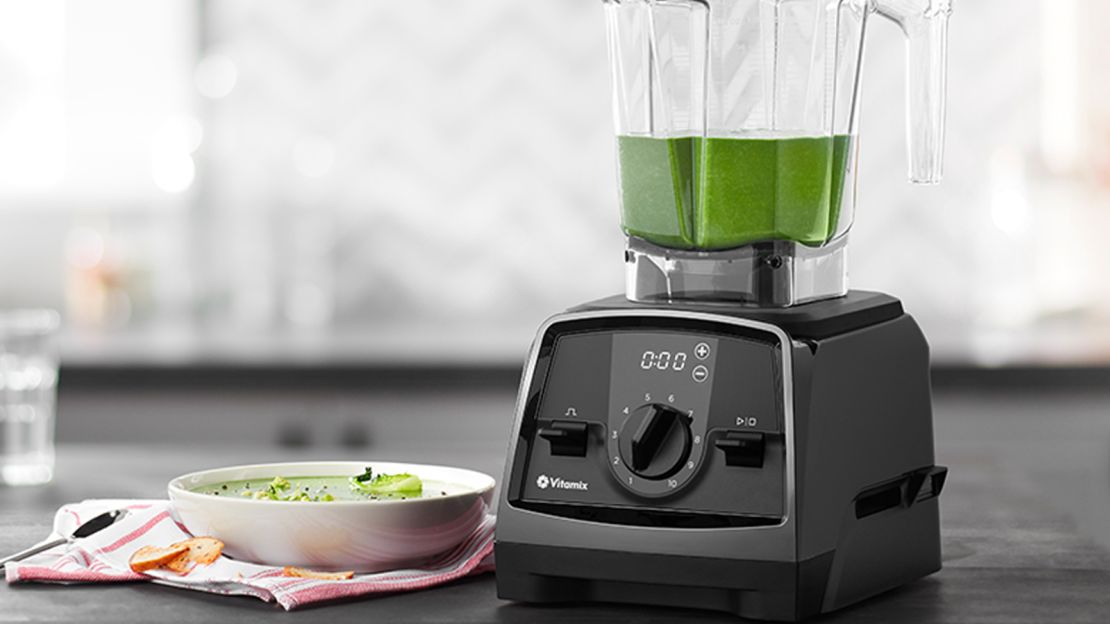
Choosing your favorite Vitamix model is a little like naming your favorite child. The three blenders we tested from the long-trusted brand all had standout qualities and delivered impressive results that outdid all other competitors; we’d be happy to give any one of them permanent resident status on our kitchen counter. But when we added up all the scores and placed ourselves in a “Sophie’s Choice” sort of situation, the Venturist V1200 was the clear winner.
Yes, it was one of the priciest blenders we tested. But when it came to turning out smoothies that were oh-so-thick, creamy and 100% silky-smooth peanut butter that has permanently scarred us from purchasing mass-produced versions ever again, soup that was velvety, chunk-free and piping hot, and ice that was perfectly crushed into snow-like flakes? Well, it just can’t be beat.
The model is similar to those in the brand’s Ascent Series (we tested the also-wonderful Ascent 3300), with both featuring a 1,400-watt, 2.2-peak horsepower motor, digital timer, 10-speed manual dial, pulse control and on/off switch. Both have shut-off times of 6½ minutes to help prevent overheating, include 64-ounce jars, and come with tampers and hardcover cookbooks. Both are also considered smart blenders: They use Bluetooth technology to sync with the Vitamix Perfect Blend app that includes 17 preset programs (from smoothies and hot soups to dry chopping and baby food), along with recipes and commands that allow you to control the blender wirelessly. The lines also use “self-detect” technology that senses and automatically adjusts the blend time depending on the container you’re using. The Venturist, however, also comes with an 8-ounce blending bowl and a 20-ounce blending cup, tamper holder and blade scraper (you’ll save about $20 over buying those accessories separately).
Don’t need all the techy bells and whistles? You can’t go wrong with the Vitamix 5200 Standard. It has all that Vitamix power and a taller, narrower, high-profile container. In fact, this is our one nit to pick with the Venturist: Its low-profile container design is awesome for blending up big portions, but it doesn’t work as well as the 5200’s narrower version (read more on the 5200 and the Ascent A3300 below).
But back to our praise for the runner-up: We oohed and aahed at the Venturist’s ability to deliver extra-silky soups and smoothies — no fruit seeds or flecks of leafy greens or herbs to get stuck in your teeth, no tiny hunks of ice, no bits of stringy celery, no clumps in protein shakes. True, you’ll want to take the time to swap in the 8-ounce cup when blending up a small amount of peanuts into peanut butter (trust us, you’ll get much better results). And the 20-ounce cup is probably better for making a single smoothie. And, yeah, you’ll need room in your cupboards to store all your new accessories. But if you take the plunge and decide to invest in this expensive, but fabulous blender? We promise your cost per use will make it an easy purchase to justify.
Make no mistake: This model, which combines crazy horsepower with Bluetooth technology along with a great range of container sizes, tools and more, costs a lot. But if you use a blender daily, it’s worth saving your pennies for this Cadillac of kitchen appliances.
Best budget blender: Ninja Professional Plus Blender with Auto-iQ
$150 $117 at Amazon and $130 at Target
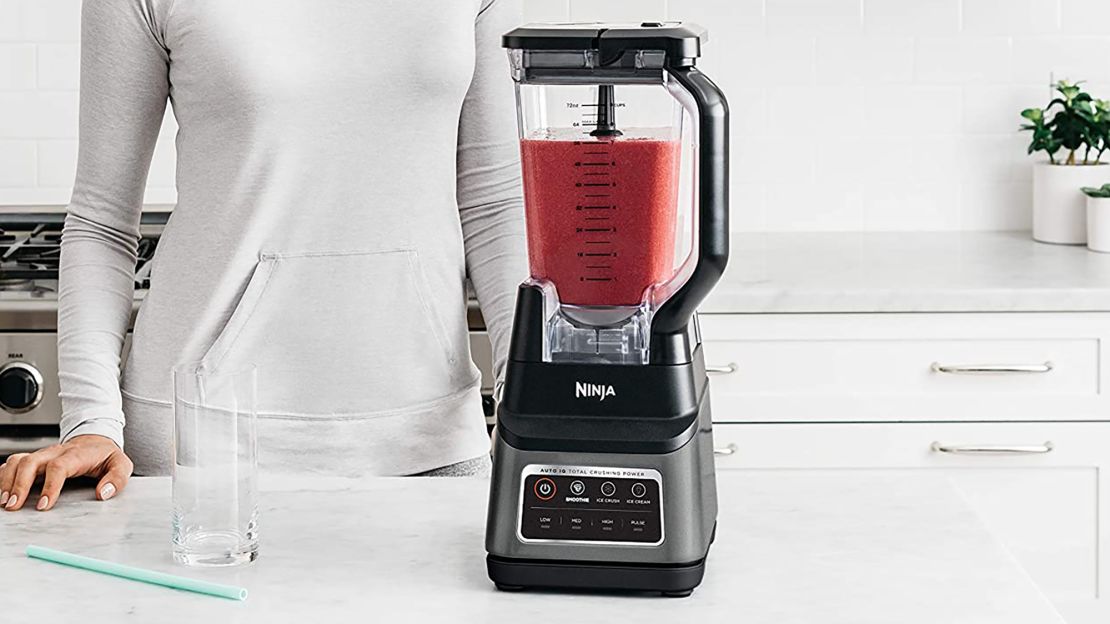
We’re just going to say it: The stacked, triple-blade design on the Ninja’s Professional Plus intrigued us — but we also found it a bit terrifying. Is it a cool, smart way to chop, blend and puree? Or is it a torture device? Depends on your motives, we suppose. But once we (gingerly) placed the blade into its base within the container, we quickly softened and found ourselves impressed with this machine.
It doesn’t carry the oomph of the high-performance models we tested. But the affordable blender models in the under-$40 range typically have much lower motor power, and therefore just don’t perform at the same caliber as a machine, like this one, that boasts 1,100 watts of motor power.
The plastic materials look nice enough, but have none of the heft of their more expensive counterparts. The plastic jar/pitcher is quite large at 72 ounces and it features presets (referred to as Auto-iQ), including smoothie, ice crush and ice cream, which are nice for hands-off blending. It also has manual settings of low, medium, high and pulse.
All pretty standard stuff. But other little touches — suction cups on the bottom keep the blender firmly grounded, the jar clicks into place to ensure it’s on the base tightly, the lid snaps down when you align its arrows and has a release mechanism for removal — earned extra points.
That’s not to say it’s perfect: Visions of slicing your hands while cleaning it may haunt you, and the jar is quite tall, meaning you likely won’t be able to store it under your top cabinets on the counter. But with that patented three-blade design, it whipped up a pretty darn good smoothie (albeit with specks of berry and a texture that leaned a bit more toward icy than creamy), a well-blended soup (reheating necessary), and nicely crushed ice that was almost all snow-like, save a few larger shards. The nuts blended into more of a nut meal or flour than butter, but if you’re a casual blender user, this model is definitely worth a spin.
Once you get over the scariness of the Ninja’s triple-stacked blade, you’ll be impressed at the smoothness this blender produces. Plus its cool features, including the lock-into-place base and click-and-release lid, made it stand out from other models.
Best practices for blenders
As with most small kitchen appliances, all blenders are not created equal. In fact, for a tool made primarily to blend, puree, stir and mix, consumers face a huge variety when considering their options. From personal-sized models meant to whip up single servings or small batches, to basic inexpensive to moderately priced versions that can handle more volume, to high-performance, commercial-grade machines that may hit you with serious sticker shock but also take blending to a whole new level, picking the right machine can be a bit of a, well, whirl.
So, which model is best? If you drink smoothies daily, are into juicing, like to whip up your own nut butters and flours, regularly eat soups, love a super-emulsified salad dressing or just spend a lot of time cooking at home in general, a high-performance blender may be worth the higher price tag.
The biggest thing that sets these models apart from the rest of the crowd is their motor size. High-performance models clock in at a powerful 1,400-plus watts, while budget blenders are typically in the 500-watt range. Higher-powered motors mean you get the right vortex needed for creamier blends, especially when blending fibrous fruits and vegetables, herbs, nuts and thick smoothies and drinks. A good rule of thumb: Go with the highest number of watts your budget allows.
As for the blade, look for one made of stainless steel for sharpness and durability. Vitamix, for example, uses aircraft-grade stainless steel blades to keep blending results consistent and dullness at bay.
Next up: the container jars. Plastic is standard for most blenders, and the most expensive models are made using BPA-free Tritan plastic, a superdurable, shatterproof and lightweight material that comes with a long lifespan. Glass, of course, is less likely to stain or absorb food odors, but can break and doesn’t play well with high-speed blades and wattage. Many of these containers have a capacity of 64 ounces or more, meaning you can blend up several servings at a time (great for entertaining), and some come with smaller-sized accessories, such as dishwasher-safe smoothie-to-go cups that often can be used as an attachment.
If you’re the type of home cook who likes to set it and forget it, a blender with preprogrammed settings may be right for you. Many blenders feature one-touch buttons for smoothies, soups, crushing ice, clean cycles, dips and spreads, and more. Variable speeds — allowing you to manually set your blend from low to high — are standard, as is a pulse button that lets you start and stop as needed. Some higher-end versions also come with timers, helping to take some of the guesswork out.
Soup lovers, in particular, will be drawn to the high-end versions for their game-changing “hot soup” ability: Simply add your ingredients, set the timer or select the preset soup button, and after about six minutes of blending, your soup is cooked, steaming hot and ready to eat right out of the pitcher. But remember: Just because it has a preset doesn’t mean one press of a button will result in a perfect blend.
Attachments are also fairly common. If you don’t plan to use your blender very often, you probably don’t need the add-ons. But if you like to take your morning smoothie with you on the go and have the storage space, smaller cups or attachments are convenient.
Our favorite accessory, however, is the tamper, a plastic tool made to insert through the blender’s lid to help break up air bubbles or other jams while the machine is still running, and sized so that it won’t hit the blades, which could lead to damage. If you don’t have a vortex while blending your thick smoothie, instead of stopping the machine, taking off the lid, using a spoon or adding more liquid to get things moving again, simply tamp the ingredients down into the blades and you’ll likely be right back in business.
Finally, a note on cleaning. After years of using blenders that needed to be taken apart and hand-washed or placed in the dishwasher, where they take up so much room, we have finally discovered that cleaning a blender could not be easier. Just fill the container halfway with warm water, add a couple drops of dish soap and give it a blend. Rinse it out — if you were blending something with oil, you’ll still need to wipe it out a bit — and you’re set.
How we tested
We ran each blender through the same four tests to see how well they performed when making a green smoothie, making vegetable soup, turning peanuts into peanut butter and crushing ice. If included, we used the applicable preset program on the model (for example, smoothie, soup or ice). We used the exact same ingredients for each blender tested. The models we tested covered a large price range: from $40 to a truly splurge-worthy $650.
We also evaluated:
- Functionality: We compared how well each blender tackled the four food tests (Were the smoothies creamy? How smooth was the soup? Was it able to handle grinding nuts into butter? Was the ice a snow-like consistency or chunky?). We also considered noise levels (spoiler: they’re all loud) and how easy they were to clean.
- Build: We ranked the blenders on their ease of use, including whether controls were clearly labeled, the number of settings included, how easily the blender fit into the base and how secure the lid was, overall quality of materials and counter appeal, including size and overall aesthetics.
- Durability: Considerations included each blender’s ability to withstand everyday use, including susceptibility for the jar to stain or crack and nicks on the blades, its ability to hold up to frequent washing cycles, and motor power, especially when run for longer periods of time.
- Warranty: We took into account how long warranty plans were for each model, with more points scored for longer, extended plans.
Other blenders we tested
Vitamix Ascent A3300
$650 at Vitamix
This smart blender workhorse was one of our faves. With a 1,400-watt motor, it has a simple interface with a digital timer display, 10 variable settings, plus an on/off and pulse button. But tech geeks will love the fact it can be controlled by app via Bluetooth, allowing you to choose from 17 presets. A large, low-profile 64-ounce container lets you blend up big batches of creamy smoothies, hot soups, tasty nut butters and more, and “Self-Detect” technology means your blender knows which container you’re using, should you decide to customize your blender with different-sized versions. It comes in brushed stainless metal, black or gray, and although it’s an investment, it comes with a free 10-year warranty. It passed all our tests with flying colors and only lost out to the Venturist because it comes with fewer accessories.
Vitamix 5200 Standard
$500 From $410 at Amazon
Simply put, this is a great blender. The taller, narrower 64-ounce container was our favorite style, leaving plenty of space for ingredients, but also mixing up things like peanuts more easily because of its shape. The intuitive controls include a 10-speed dial, on/off switch and high-speed variable control, and it performed wonderfully on all our tests — especially in turning peanuts into peanut butter. The laser-cut, stainless steel hammermill and blades, color options of black, red or white, and generous seven-year warranty just add to its appeal. When it came to performance, however, it was close, but not quite as good as its Venturist and Ascent siblings. Those two models made thicker, creamier smoothies and more velvety soup that was also hotter in temperature.
Oster Versa Pro Series
$312 at Amazon
Packing a lot of motor power at 1,400 watts, this model bridges the gap between value and commercial-grade blenders. Plusses were its 64-ounce BPA-free Tritan jar, preprogrammed settings (smoothies, soups, dips and spreads), manual variable dial, ability to make hot soup, inclusion of a tamper and recipe books, and its seven-year warranty. It could have performed better on the smoothie setting. It took us multiple cycles to get our ingredients all blended, and we needed to use the tamper a lot to keep the vortex swirling, but we did end up with a pretty creamy drink in the end.
Oster Texture Select Pro
$111 at Amazon
We like that this under-$150 model boasts a durable 64-ounce Tritan jar, stainless steel blades, a 1,200-watt motor, presets of smoothie, shake, or food chop, and manual settings of low, medium, high and pulse. It also has buttons that allow you to choose a thin, medium or thick consistency — but we can’t say we noticed much of a difference while testing them. Compared with other models, this one was pretty average. We needed to use the included tamper on the smoothies, which were decently smooth, but left a few small chunks of ice remaining. The peanuts were more mealy than buttery. The soup was creamy, but required reheating. The ice was mostly snow-like, but some shards remained. Overall, it was not bad, not wonderful, but perfectly fine.
Hamilton Beach Professional
$270 at Walmart
We can’t say we were particularly wowed by this model, but its 1,800-watt motor did deliver an exceptionally thick and creamy smoothie once we used the included tamper quite a bit — and quite vigorously — to get that perfect vortex created. It didn’t quite get peanuts to turn into peanut butter, perhaps partly because of its large, 64-ounce BPA-free jar, but it did deliver a velvety hot soup and crushed ice into snow. The controls are very basic — just a pulse, start/stop and 10-speed dial — and the build is OK, but doesn’t scream “durability.”
Hamilton Beach Smoothie Smart
$45 $40 at Hamilton Beach
If, for you, a blender is purely a vessel for making smoothies, this inexpensive model is worth a look. Small in size, with a hefty 40-ounce glass jar, it will nestle nicely under cabinets on your counter. The blender includes five presets: smoothie, pulse/ice crush, puree/icy drink, mix/milkshake and stop. But no variable speed dial is included. As for results, it made a quality smoothie, although we had to run it through the preset cycle twice to get everything blended. (Well, almost everything; we did find one large spinach leaf stuck to the side of the jar that didn’t get mixed in.) It was creamy and thick, with just a few flecks of berry throughout. The machine also made a fine soup and crushed ice more into snow pebbles rather than flakes, and it didn’t like the peanut test at all. Some the nuts were chopped, a few were turned into a sand-like texture, and several stayed whole.
Kitchen Aid K400
$300 $210 at Amazon
If we were judging blenders based solely on aesthetics, this sleek version, in a perfect soft blue shade, would be our clear victor. But since looks are only part of the scorecard, we stopped oohing and aahing over its appearance and put it to the test. The variable-speed blender includes a five-speed dial and three presets: smoothie, ice drinks and ice crush. The smoothie preset resulted in a thick, uber-creamy drink that blended everything up perfectly. The asymmetric blades did an OK job on the peanuts, but they were more floury than buttery. Soup was nice and smooth. Ice? Just right for our next round of cocktails. Also available in silver, white, black, pistachio or red, this is a solid workhorse of a blender. And those looks? Feel free to stare.
